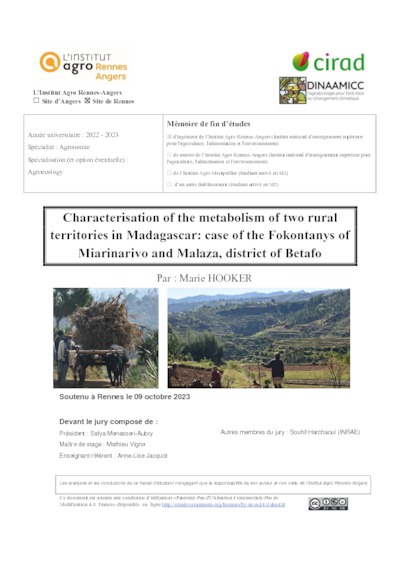The study of the metabolism of these two fokontanys revealed the intensity of biomass uses through all their forms, as well as the diversity of strategies at farm and territory scale. Indeed, all produced biomass finds a use in household consumption, market sales, livestock production, energy consumption or fertility management. This participates greatly to the autonomy of the territory. But it may also lead to competition in uses, and unbalances at territory scale, since a lot of biomass is exported as cash crops or animal products. ➢ Two territories with different issues regarding autonomy Malaza is market oriented. Miarinarivo is subsistence oriented, with developing market opportunities. Despite their geographical proximity and their similarities in the general structure of flows, they present two different types of metabolism. Malaza is a very productive territory, and the market opportunities are making it more and more intensive. The pressure over all types of land is high, and even though crop-livestock integration enhances circularity within the fokontany, the input/output balance seems unbalanced. Miarinarivo is also very productive, but much less intensive. The external markets do not represent as great a pressure on the territory, allowing the households to produce for themselves before thinking of selling outside. The fokontany’s biomass flows are organised upon a strong autonomy, in which livestock plays a preponderant part. Further works including conversion of biomass flows to substance flows (N, P) should allow to reconsider these questions with a more precise vision of the flows and especially the calculations of indicators of circularity, autonomy and sustainability. ➢ Multiple potential drivers of flows The question of the governance of the flows must be answered to place the metabolism diagrams in the frame of territorial ecology. The results obtained through this preliminary work provide a few hints regarding the major drivers of the flows: • The main land uses and resource accessibility. It was one of the main hypotheses in this work, and was verified: the different land uses lead to various accessibility to biomasses, therefore different flows within the fokontanys and within the households.
Characterisation of the metabolism of two rural territories in Madagascar: case of the Fokontanys of Miarinarivo and Malaza, district of Betafo
État des lieux pré-projet sur les productions animales dans les villages riverains du parc Makira
Des millions de gens dépendent de la viande de brousse pour subvenir à leurs besoins alimentaires et financiers. La viande de brousse constitue une source importante de protéines, de matières grasses et de micronutriments, en particulier pour les peuples autochtones et les communautés rurales dans les régions tropicales et subtropicales d'Amérique latine, d'Afrique et d’Asie. La demande de viande de brousse est en pleine explosion, spécialement dans les zones urbaines. Si la chasse d’animaux qui fournissent de la viande de brousse n’est pas réduite à un niveau durable, les populations d’espèces sauvages déclineront et les communautés rurales souffriront d’une insécurité alimentaire croissante. De récentes études ont montré que la chasse excessive d’animaux pour s’approvisionner en viande de brousse menace des centaines d’espèces sauvages d’extinction. Entre 2018 et 2024, le Programme de gestion durable de la faune sauvage (SWM Programme) améliorera la conservation et l'utilisation durable de la faune


